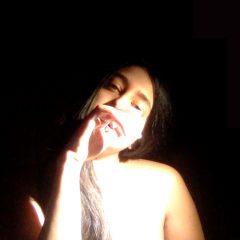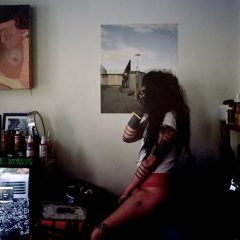Artists have been redubbed as uploaders and downloaders in >Get >Put, a new show at Little Berlin gallery that was partly kindled by The Sound of Downloading Makes Me Want to Upload, a book by The Institute of Social Hypocrisy. Curator Kelani Nichole circulated copies of that book to artists in this show. Including essays and creative works pieces by Paris-based Victor Boullet and several other artists, the book celebrates the inevitable distortion of information transmitted in the digital process, shown clearly in Boullet’s own contribution to the book, an abstract, jumbled-letters version of “Krapp’s Last Tape” by Samuel Beckett.
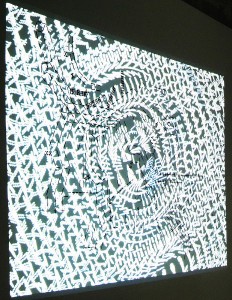
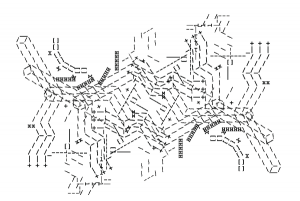
Recursive digital loops and their accompanying distortions feel gleeful in A. Bill Miller’s “gridworks_walldrawing2,” which was performed live at the show’s opening and remained on the wall as a stagnant diagram afterward. Miller is “a downloader consuming the grid, processing and producing work through function and error of machine,” according to his show bio. The performance incorporated live video of the diagram and projection field. That visual information was re-projected as ASCII code characters, which were in turn re-interpreted as raw visual data and re-projected as more complex streams of characters, while Miller added improvisations and played music. At the core of the performance, a brief text was projected about the insubstantiality of objects in the invisible world of data, partly including:
_____it was/is nothing left____________
______an unresolved image____________
______it was a phosphene_____________
______there was/is no grid____________
__________________________________
________[[[[][][[][][][][][][][][]
][][][][][]]]][][[[][][][[[[][][]]sponsored
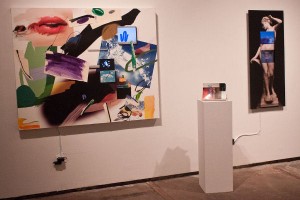
Alexandra Gorczynski’s video projects are like self-portraits by an identity dismantled by a digital information overload. “tidalwave.jpg” takes a classical image of femininity and then censors the breasts and vagina with screens showing a laughing mouth, clouds, silicone-implanted breasts, and other images.
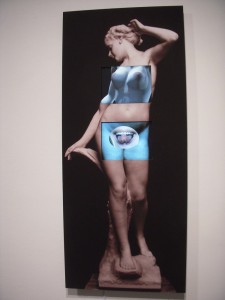
“PLUR Piece II” is like a canvas of the internet world, with abstract blotches of color and water splashing around the two scattered screens, flickering with images of clouds and a mouse icon. The internet as a “cloud” feels like it directly inspired the composition of the piece, but the massive lips in the piece make the intangible internet cloud seem like a sensual pleasure to be enjoyed.
The exhibition also included The Internet for Women, a corny 1995 book by Rye Senjen & Jane Guthrey which Gorczynski filled with pressed flowers to emphasize the outdated conceptions of gender represented by the book. Her video in response to the book, “Top 100 for women,” available only with the downloadable version of the exhibition, shows the artist hyperactively contorting herself into stereotypically feminine poses while hypnotically staring at the dull glow of the screen as a list of the so-called top 100 websites for women scroll by, like an identity pressure that’s addictive yet clearly painful and unnatural.
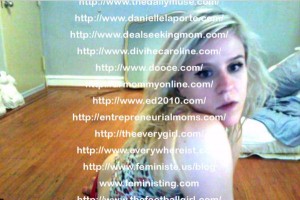
Like Miller’s film, Giselle Zatonyl represents the uploading/downloading dynamic as a recursive loop. “The Internet” is the title of her perpetual water-producing fan system, which exists in an imperfect physical form, directly beneath a video of an idealized model of the fan in an infinite, virtual reality environment with ethereal, ambient music playing. The piece is both an attempt at symbolically representing the digital world, producing the information or water that feeds itself, and of the inability to recreate digital concepts in the physical world.
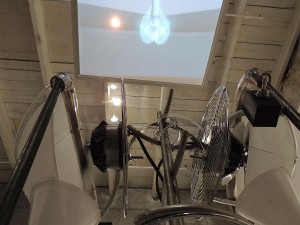
Zatonyl’s real-life fan is rickety and looks like it might cut your hand off. In the video, an unreal camera gracefully swoops around an immobile virtual fan on an infinite horizon with water endlessly spurting out of it. Created with out-dated three-dimensional graphics that look eerily reminiscent of the clumsy computer imagery of the 1990s, the virtual reality version doesn’t need an elaborate tubing system to act recursively — it is just programmed to go on forever. Suddenly we’re questioning Aristotle’s definition of inanimate objects as incapable of moving without an external force, and wondering, if all people disappeared tomorrow, would the internet keep going?
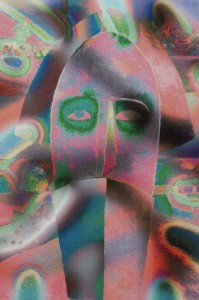
Travess Smalley’s remix of Malevich’s “Head of a Peasant” takes the original work into new fluorescent territory. Part of a series by Smalley printed in a booklet with the title, “Helmet Mask with Praying Mantis and other masterpiece reproductions I’ve scanned,” the works resemble Richard Avedon’s famous 1967 portraits of The Beatles. The original Malevich is completely reworked and virtually effaced with Smalley’s new palette, the agricultural background replaced by flowing streaks of color. Even the subject’s expression seems completely changed, like a figure plucked from the past and placed in the digital present. The partly reflected and refracted color patterns of the image feel compellingly like the distortion of digital transmission, though the archaic expression of the figure is universal and timeless.
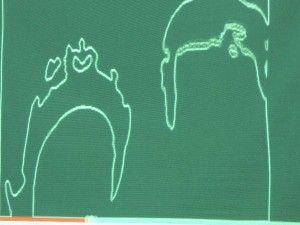
Benjamin Farahmand’s piece, “Lo and Behold, I am Become as a God,” invites each viewer to become an uploader by stepping into a booth and being videotaped reading a line from “Flatland” by Edwin Abbot. Farahman’s distortion of choice is flattening the faces of his readers into “Flatland” characters – each video is reduced to minimal visual information, just partial white outlines around the shape of faces on a black background. All these videos are automatically uploaded to a YouTube playlist, again making automatic self-perpetuation a theme here. After all, just by participating as uploaders, guests are creating a specter of themselves that will exist online long after their own inevitable death.
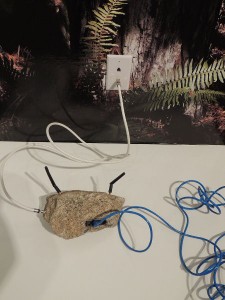
Derek Frech made a fake modem out of a rock, like a naturally occurring data transmission device. But nothing can be transferred through a rock. Perhaps this image of the natural world is the full stop for the exhibition, where the online information that flows freely and recursively through the rest of the show finally comes up against the natural world and cannot pass any further.
>Get>Put, which is available in a slightly different downloadable form on Rhizome.org, will be up at Little Berlin, at 2430 Coral St., through Nov. 30. A closing roundtable will be held Saturday, Nov. 24, from 7 to 10 p.m.



